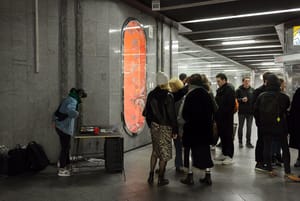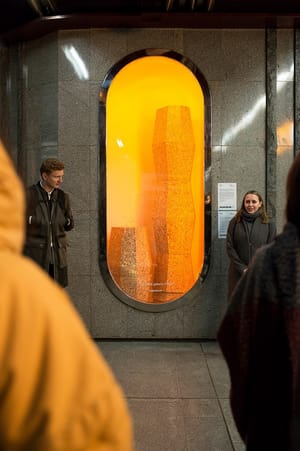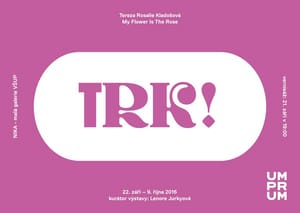- City
- Praha
- Street
- Karlovo náměstí – vestibul metra B (výstup na Palackého náměstí)
- galerienika@gmail.com
- Founded
- 2012
About venue
NIKA, a small gallery of the Academy of Arts, Architecture and Design (UMPRUM) in Prague, operates on a similar principle as Gallery UM and Gallery 207 under the banner and funded by the Academy of Arts, Architecture and Design (UMPRUM) in Prague. Unlike its sister galleries, however, it is situated outside the school premises, in an exposed location at the Karlovo náměstí metro station (exit Palackého náměstí). It has a form of a showcase the original purpose of which is not entirely clear. As an exhibition space run by the Academy, NIKA provides a platform for experimental interaction between students of theory, lecturers and artists and succeeds in fulfilling its mission to connect the disciplines and ideas fostered at the school.
In 2012, curator Tereza Jindrová who was a student of History and Theory of Art at the Academy at the time, noticed the unique space in the lobby of the Karlovo náměstí metro station. The empty oval-shaped showcase, easily accessible and situated in a busy area, seemed ideal for displaying student projects. With the help of Rostislav Koryčánek, the former curator of the project, Umění v metru, Tereza Jindrová found out that the company managing the space was JCDecaux that takes care of the city’s advertising street furniture. The company provided keys to the showcase for free and also covered the financial costs associated with electricity until 2020. At that time, however, JCDecaux entered into a lawsuit with the Capital City of Prague Transport Company in relation to the circumstances connected with the contract concluded between the two parties in 1997. Fortunately, that did not affect the operation of NIKA Gallery and thanks to a project of the Prague Transport Company focusing on the architectural design of Prague’s metro the contract was prolonged.
The primary intention of the gallery has been to present the work of the Academy’s students outside the school environment, while the specific character of the space and location allows for experimentation and the creation of (not only) site-specific projects. The gallery is financed by the exhibition department of the Academy of Arts, Architecture and Design in Prague, but its actual operation falls exclusively under the supervision of students from the Theory Department, who, usually in pairs, take turns after each academic year. The rhythm of the gallery thus relies primarily on the individual personalities of the curators who are in charge in the given year. They are selected from among the students and the process is completely open – anyone from the Department can apply, but usually second-year students do. Students of graphic design and photography are also a creative part of the gallery’s operation. Before the start of each new season, projects from the open call submitted by the Academy’s students are selected for the exhibitions.
Each of the exhibitions is up for approximately one month. In addition to exhibition projects by students from the Academy of Arts, Architecture and Design, visiting students from other art schools, such as the Film and TV School of the Academy of Performing Arts or the Academy of Fine Arts, can also take part (often during the summer months). The exhibition programme of the gallery apparently aims at striking a balance between free and applied art, with design and various media from painting to sculpture alternating within the individual displays. Despite the significant limitations of the exhibition space – as, for example, the difficult installation conditions especially during the winter – NIKA allows for public involvement and lively interaction, which remains one of its main advantages.
Marie Tučková, for example, integrated the communication with random passers-by, who unknowingly become the gallery’s visitors, in her site-specific project in 2016 – an “exhibition” (or rather a performance) “If they buy curtains, it ends up as if the lights went out. The gem was stolen, the Venus was moved, the polar bear wandered off to eat.” The artist was present in the space of the NIKA Gallery starting at an unannounced time and date and behaved as she were in her own room. The photographs that were documenting the whole event later served as exhibits. “I see the showcase as an analogy to my window, leading from the inner intimate space to the outer space, and vice versa. The window being a boundary between the outer space and the inner space. I invite the passers-by to look in through the gallery window, into the bowels of the gallery, and thus to become observers themselves.” (Marie Tučková, https://www.umprum.cz/web/cs/galerie-nika/pripravuje-se-3500, accessed 21 June 2021)
Another exhibition project dealing with the communication with the outside world was Regulované utrpení (2019) by Matúš Buranovský, who in his site-specific installation worked with the connection of two incompatible worlds: street art versus a world in which street art is generally considered as vandalism. Matúš Buranovský, together with writer Honza Hrnčíř, sprayed the exhibition glass of the NIKA Gallery and then “regulated it into a gallery matter in front of the visitors” (curator Alice Vítková, https://www.umprum.cz/web/cs/galerie-nika/matus-buranovsky-regulovane-utrpeni-8826, accessed 21 June 2021).
Both of these exhibitions are based on a noticeable intervention into public space outside of the NIKA showcase, enabled by the gallery’s experimental character. Exhibitions of this type also reveal the considerable freedom that this project provides, which may not be obvious at first sight.
Since its foundation, more than 15 students of the Theory Department have become the project’s curators. Curators for academic year 2012/2013 were Adéla Procházková and Tomáš Klička, followed by Jana Pavlová in 2013/2014, Markéta Jonášová a Tereza Hrušková in 2014/2015, Tereza Hrušková by herself in 2015/2016, Lenore Jurkyová and Michal Vaníček in 2016/2017, Klára Hudáková and Tereza Škvárová in 2017/2018, Kamila Huptychová and Alice Vítková in 2019, Zuzana Dusilová, Mariana Pecháčková and Eva Slabá 2020/2021, and finally Anna Crhová and Anna Roubalová since March 2021.
- Author of the annotation
- Mariana Pecháčková
- Published
- 2021
Exhibitions
- Selection of exhibitions and other events
2021
Viktor Eichler a Martin Eichler – my life be like
Leevi Toija – Free Man / Restricted Man
Karolína Matušková & Lucie Zelmanová – Sugar Be My Caramel: Forever
2020
David Válovič – Magneto
Jiří Macků, Vítek Jebavý, Luciana Kvapilová – Feedback Loops
Marie Holá – Power Yoga
2019
Minami Nishinaga – Krmítko
Matúš Buranovský – Regulované utrpení
Darja Lukjanenko – Symptoms of the World
2018
Adam Tippl, Tamara Salajová, David Fořt – EVA SPACE
Ihor Sabadosh – Brand New Trash
Lenka Glisníková – Heyy, I am here!!
2017
Matyáš Machat – Neodešel
Vendulka Prchalová – Vere imo
Ateliér skla VŠUP – Okno
2016
Marie Tučková – Koupí - li si záclony, skončí to, jako když zhasne. Drahokam byl ukraden, Venuše přemístěna, lední medvěd odešel žrát.
Petr Dub – Domovní znamení
Kateřina Palešníková – Sui generis
2015
Lucie Lučanská, Jakub Plachý – Minimarket: cigarety balené pivo domácí zvířecí alcohol
Ted Whitaker – Miss Scarlet in the Lounge / Slečna Scarlet v salónku
Martin Jakobsen, Kristýna Venturová – Za sklem
2014
Alžběta Bačíková, Barbora Švehláková – Jednou budem dál
Josefína B. Jíšová – Infuze
Dimitri Nikitin – Tinctures
2013
Martina Nosková – Žrebovanie
Vojtěch Rada – Amnestie
Pavel Jestřáb – Nejasnosti kolem jestřábího oka
2012
Adéla Doušová, Anna Leschingerová, Petra Pavelková, Lenka Šindelová – Růst za sklem
Filip Dvořák, Lucie Patáková – HULK
Matěj Hanauer – Pilulka
Video
Photo
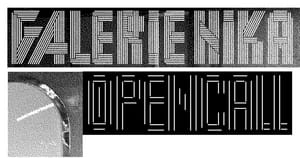 OPEN CALL for The NIKA Gallery 2019 Before the start of each new curatorial season, there is a selection of projects from the public open call, intended for students of the Academy of Arts, Architecture and Design in Prague. Graphics: Jiří Macků
OPEN CALL for The NIKA Gallery 2019 Before the start of each new curatorial season, there is a selection of projects from the public open call, intended for students of the Academy of Arts, Architecture and Design in Prague. Graphics: Jiří Macků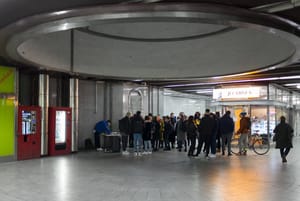 The NIKA Gallery is located outside the school grounds, in an exposed place in the metro on Karlovo náměstí (exit Palackého náměstí). Photo: Karolína Matušková
The NIKA Gallery is located outside the school grounds, in an exposed place in the metro on Karlovo náměstí (exit Palackého náměstí). Photo: Karolína Matušková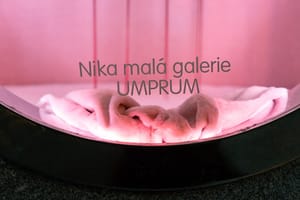 NIKA, a small UMPRUM gallery, functions in the same way as the UM Gallery and Gallery 207 under the heading and from the budget of the Academy of Arts, Architecture and Design in Prague. Photo: Karolína Matušková
NIKA, a small UMPRUM gallery, functions in the same way as the UM Gallery and Gallery 207 under the heading and from the budget of the Academy of Arts, Architecture and Design in Prague. Photo: Karolína Matušková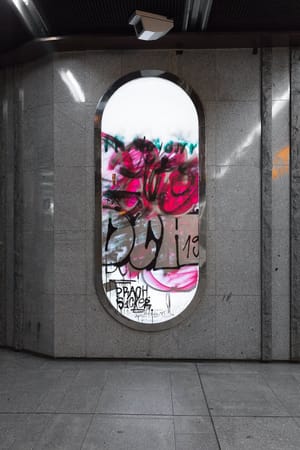 Matúš Buranovský worked in his site-specific installation on the exhibition Regulované utrpení (2019) with the connection of two incompatible worlds - street art and the generally accepted opinion on this matter as a riot. Photo: Karolína Matuškova
Matúš Buranovský worked in his site-specific installation on the exhibition Regulované utrpení (2019) with the connection of two incompatible worlds - street art and the generally accepted opinion on this matter as a riot. Photo: Karolína Matuškova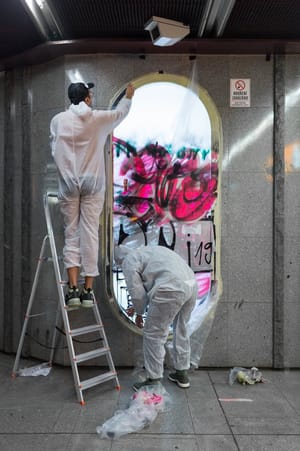 Within the NIKA Gallery, the author of the exhibition, M. Buranovský, spray-painted her exhibition glass with the writer Honza Hrnčíř, and then "regulated it to a gallery matter in front of the visitors" (curator Alice Vítková) Photo: K. Matušková
Within the NIKA Gallery, the author of the exhibition, M. Buranovský, spray-painted her exhibition glass with the writer Honza Hrnčíř, and then "regulated it to a gallery matter in front of the visitors" (curator Alice Vítková) Photo: K. Matušková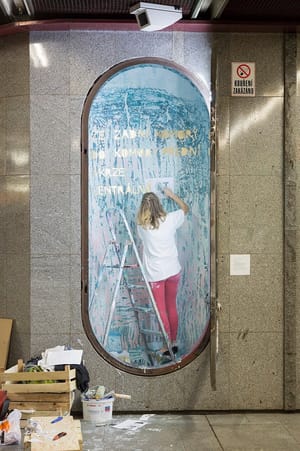 A view of Marie Tučková's exhibition / performance: „Koupí - li si záclony, skončí to, jako když zhasne. Drahokam byl ukraden, Venuše přemístěna, lední medvěd odešel žrát.“ (2016) Photo: archive of The NIKA Gallery
A view of Marie Tučková's exhibition / performance: „Koupí - li si záclony, skončí to, jako když zhasne. Drahokam byl ukraden, Venuše přemístěna, lední medvěd odešel žrát.“ (2016) Photo: archive of The NIKA Gallery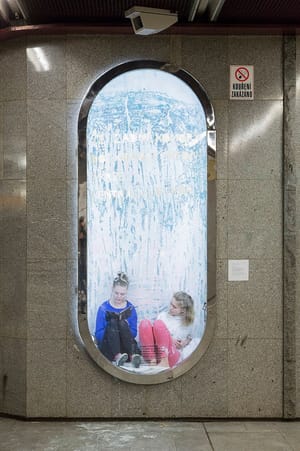 A view of Marie Tučková's exhibition / performance: „Koupí - li si záclony, skončí to, jako když zhasne. Drahokam byl ukraden, Venuše přemístěna, lední medvěd odešel žrát.“ (2016) Photo: archive of The NIKA Gallery
A view of Marie Tučková's exhibition / performance: „Koupí - li si záclony, skončí to, jako když zhasne. Drahokam byl ukraden, Venuše přemístěna, lední medvěd odešel žrát.“ (2016) Photo: archive of The NIKA Gallery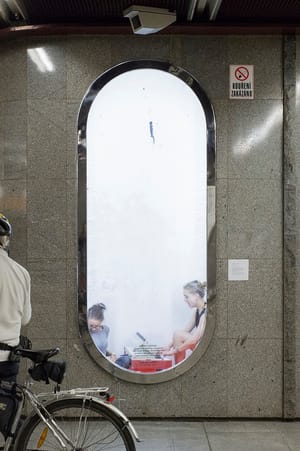 A view of Marie Tučková's exhibition / performance: „Koupí - li si záclony, skončí to, jako když zhasne. Drahokam byl ukraden, Venuše přemístěna, lední medvěd odešel žrát.“ (2016) Photo: archive of The NIKA Gallery
A view of Marie Tučková's exhibition / performance: „Koupí - li si záclony, skončí to, jako když zhasne. Drahokam byl ukraden, Venuše přemístěna, lední medvěd odešel žrát.“ (2016) Photo: archive of The NIKA Gallery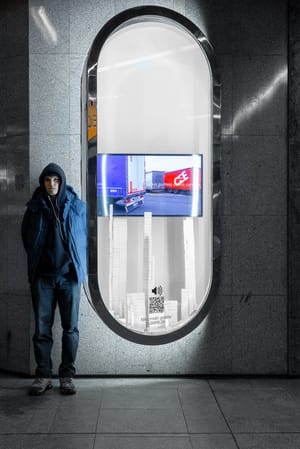 An installation view with the author, Leevi Toija: Free Man / Restricted Man (2021) Photo: Karolína Matušková
An installation view with the author, Leevi Toija: Free Man / Restricted Man (2021) Photo: Karolína Matušková
- Note
otevřeno 24/7


